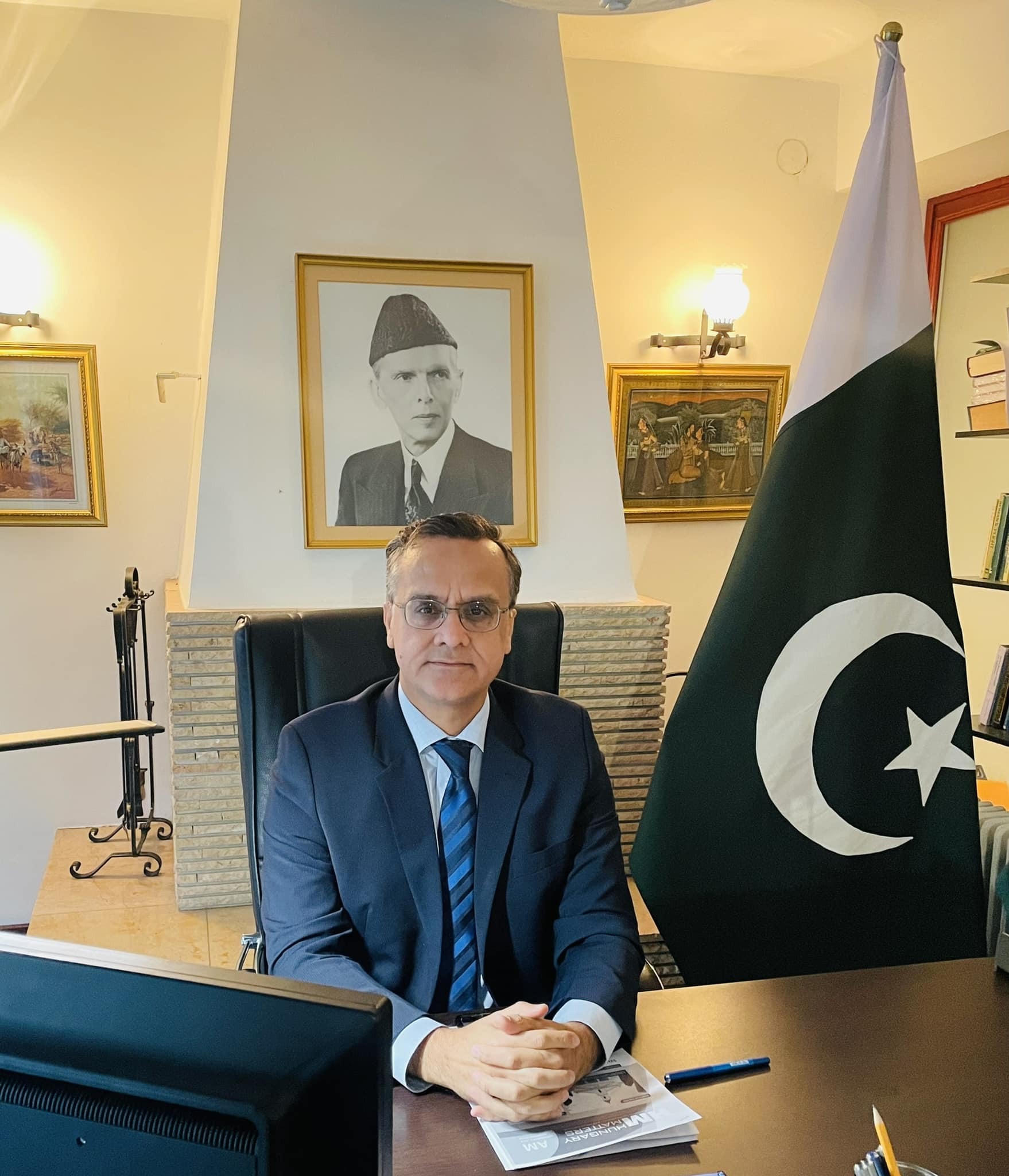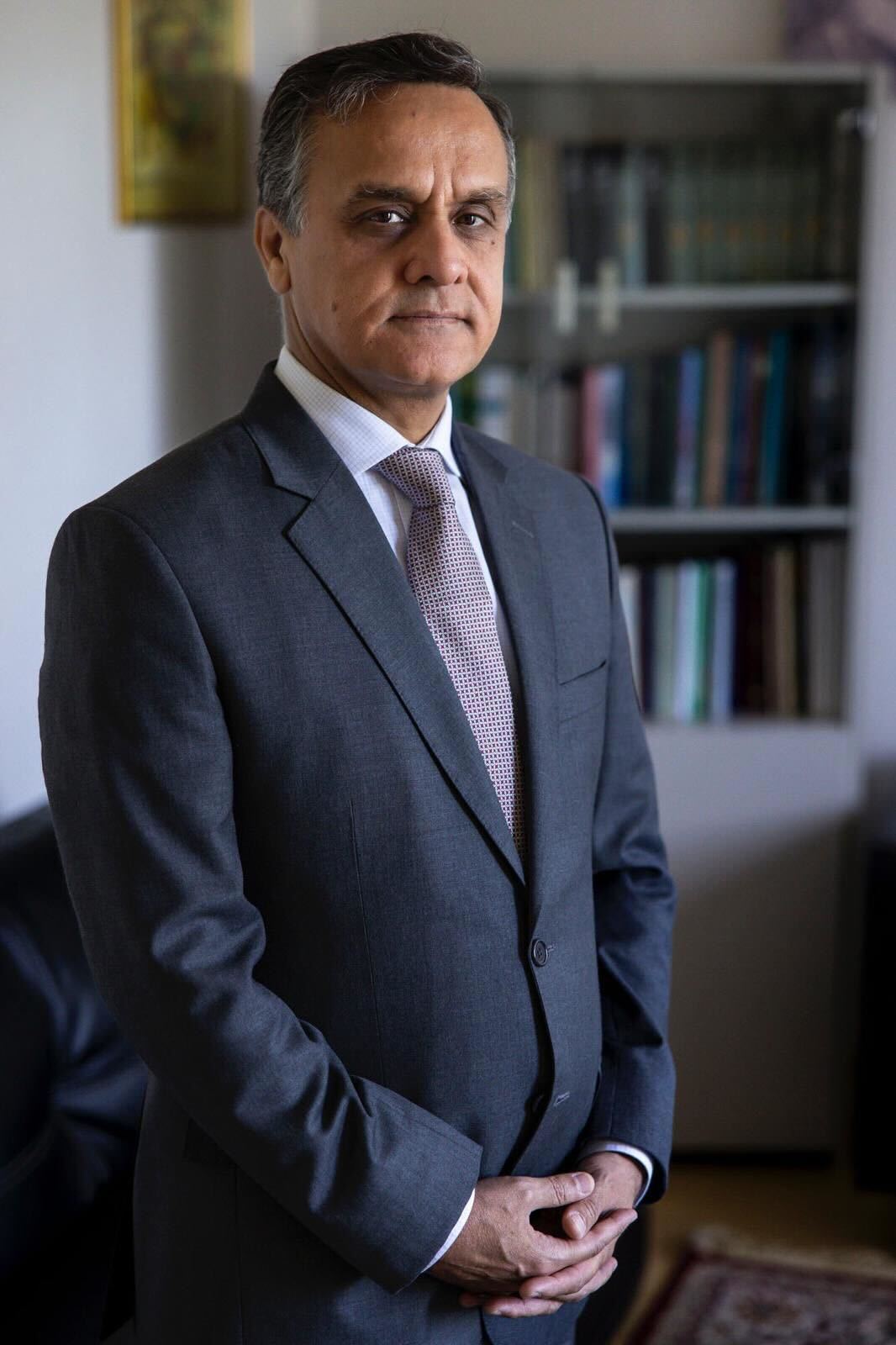Hungarian MEP appointed rapporteur for African education development

The European Parliament’s Committee on Development (DEVE) has appointed György Hölvényi, an MEP of Hungary’s co-ruling Christian Democratic People’s Party (KDNP) as standing rapporteur for education in developing countries, especially Africa.

Hölvényi told MTI on Tuesday that his two-year mandate involves assessing the state of education in Africa to obtain reliable data, and monitoring the use of the nearly 8 billion euros the European Commission had allocated to that purpose.
Progress in education is impossible until elementary schooling is in its current “insufficient” state, and hundreds of millions of children receive no education whatsoever, Hölvényi said. In view of the population boom underway, the number of teachers must be steeply increased by 2030 even to maintain the current level of basic education, he said.
Meanwhile, vocational training must be brought up to 21st-century levels in Africa, and include technological knowledge and other subjects, the lack of which is currently in the way of implementing planned investments in the continent, he said.
Read also:
Hungary, Laos agriculture ties strengthening: Minister Linkham Duangsavanh visits Budapest

Sándor Farkas, a state secretary at the Agriculture Ministry, met with Laotian Minister of Agriculture and Forestry Linkham Duangsavanh in Budapest on Monday.
The Agriculture Ministry said the sides discussed crop and livestock farming, existing cooperation agreements, and ways to enhance bilateral ties.
Farkas said Hungary’s government could support joint projects in feed production, livestock farming, meat processing and food safety in the framework of tied aid programmes.
The talks also touched on trade opportunities and cooperation in education.
Hungary offers scholarships to 150 Laotian students a year to enroll at Hungarian universities, the ministry said.
read also:
Hungarian government supports graduates living abroad by redeeming their student loans

The government will offer to refinance the student loans of Hungarians abroad, the National Economy Ministry said on Friday.
With the measure, the government aims to support the return of young Hungarians living abroad, the ministry said. Draft regulations on the measure will be posted for the public on Friday, it added.
According to the draft, young Hungarians studying abroad for their diploma who return to Hungary to work could opt to refinance their foreign student loans, up to HUF 10m, with credit from state-owned student loan provider Diákhitel.
Diakhitel credit for tuition is interest-free, while free-purpose Diákhitel loans have a rate of 7.99pc at present. Young Hungarians who avail of the opportunity would be eligible for the same preferences enjoyed by other Diákhitel borrowers, including loan discharge and suspension of repayment for families with children, and tax-free repayment support from employers.
Read also:
- Hungarian government announces 2024’s scholarships to help diaspora Hungarians
- Revealed: These are the best places to live in Hungary in 2024!
Featured image: depositphotos.com
Revealed: These are the best places to live in Hungary in 2024!

Budapest, Debrecen, and the area around Pannonhalma have been ranked as the best places to live in Hungary in 2024, according to the latest livability report from MBH Jelzálogbank. The findings show that the competition is tight, especially outside the capital, with minimal differences in scores among the top-ranking areas.
The best places to live in Hungary this year
The report, released on Thursday, assesses 174 districts across Hungary, including Budapest, and takes into account factors such as education, healthcare, culture, crime rates, job opportunities, shopping options, and housing affordability to evaluate how these aspects influence the housing market, mfor.hu reports.
In terms of education, the top performers on the list of the best places to live in Hungary are Budapest and regions in the western and southern parts of the country. Healthcare scores are particularly high in southern districts, while job opportunities vary significantly across the country.
Budapest in the top spot
As in previous years, Budapest retains the top spot in the livability rankings, followed by the Debrecen district. In third place is the Pannonhalma district, with Budakeszi rising to fourth, having placed seventh last year. Other top performers include Pilisvörösvár, Bácsalmás, Dunakeszi, and Veszprém. Notably, the Kisbér and Érd districts, which dropped out last year, have re-entered the top ten. While Budapest remains an outlier with the highest overall score, the differences among the other leading districts are marginal—Debrecen, for example, edged out Érd by fewer than four points.
Győr ranked 11th this year, followed by Pécs in 13th and Szeged in 14th.
The analysis highlights that districts in the northeastern regions tend to score the lowest, while higher-scoring districts are concentrated in the south, around the capital, and in northwestern Hungary.
Education, healthcare, culture and job opportunities

Education-wise, Budapest leads, followed by western and southern regions, while large cities in the northern and eastern areas also received high scores. In healthcare, the top three spots remain unchanged from last year: Budapest ranks first, followed by Pécs and Gyula. Overall, southern districts have the highest healthcare scores. When it comes to culture, Budapest, Debrecen, Szeged, and Pécs are cultural hotspots, with areas around Lake Balaton also ranking highly. Job opportunities show stark regional differences, with northwestern Hungary and Budapest far outperforming the southern and eastern parts of the country.
Housing affordability, crime
Unsurprisingly, housing affordability remains a challenge near Lake Balaton, where high property prices relative to income keep these districts at the bottom of the affordability rankings. Budapest also ranks among the least affordable places to live. As for crime statistics, larger cities continue to perform poorly in this regard.
On the list of county seats, Budapest once again ranks first in livability, followed by Veszprém, Pécs, and Győr. Other notable cities include Szekszárd, Székesfehérvár, Szombathely, Szeged, Debrecen, and Zalaegerszeg. Despite Budapest’s strong overall ranking, Győr outscored the capital in education and job opportunities. Housing affordability remains a weak point for Budapest, which also struggles with moderate crime risk, placing 17th in this category. The most affordable county capital is still Salgótarján, with Miskolc and Békéscsaba trailing far behind. In healthcare, Pécs ranked highest, followed by Miskolc and Veszprém.
MBH’s Best Places to Live in Hungary list
This is the fourth year that MBH Jelzálogbank has conducted its livability study, which focuses on the factors affecting housing demand across different regions of Hungary to provide an overview of the best places to live in the country. The aim is to provide a comprehensive overview of the economic, social, and infrastructural factors that contribute to a region’s appeal. Key considerations include education, healthcare, cultural access, job markets, crime rates, and shopping options.
Read also:
English proficiency ranking: Hungary among top 20, Romania and Bulgaria perform better

According to the latest English Proficiency Index ranking, Hungary is among the 20 best countries regarding English proficiency as a second language. However, Hungary was outperformed by many nations in the region, notably Austria, Croatia, Poland, Romania and Bulgaria.
English Proficiency Index
Pénzcentrum writes that a recent publication has revealed a surprising ranking of global English language skills, placing Hungary among the top 20 countries for English proficiency as a second language. In this analysis by the EF English Proficiency Index, Hungary was outperformed by several nations, including Austria, Croatia, Poland, Romania, and Bulgaria. However, the country managed to get a higher ranking than Slovakia, Estonia, and Serbia.
The survey involved 2.2 million participants from 113 countries, notably excluding those with native English speakers such as the UK, US, Canada, Australia, and New Zealand. The rankings were determined by results from the EF Standard English Test (EF SET), with the Netherlands claiming the top spot, followed by Singapore and Austria. Denmark and Norway closely followed, being just one or two points behind.

A surprising trend
Since 2015, the trend in English proficiency across various age groups has remained relatively stable, with the notable exception of 18-20-year-olds, whose average score has decreased from 537 to 448 points. Interestingly, from 2014 to 2020, women demonstrated stronger English language skills. However, recent data shows men have taken the lead. In 2023, men achieved an average score of 502 in English proficiency, while women an average of 484. Therefore, this highlights a slight shift in the dynamics of language skills between the sexes.
Hungary in the High Proficiency category
English proficiency across the globe has been classified into five categories: Very High, High, Moderate, Low, and Very Low, based on test results. To qualify as a Very High proficiency country, an average score of over 600 is required, with the Netherlands leading at an impressive 647, followed by Singapore with 631 and Austria at 616. Twelve countries, including Hungary’s neighbour, Croatia, achieved this top tier, reflecting their exceptional English language skills.
Hungary, with an average score of 588, is placed in the High proficiency category, ranking 17th out of 113 countries. This places Hungary among the top 18 nations in this group, while other European countries like Spain, Italy, and France fall into the Medium category. In contrast, the lowest performers included the Democratic Republic of Congo, Tajikistan, Yemen, and Libya, all of which scored below 400 points. Notably, Europe has seen an increase in average English proficiency by 50 points since 2011, indicating a positive trend in language skills across the continent.
Read also:
- Hungarian students win silver medals at linguistics International Student Olympiad
- VIDEO: British girl has a breakdown over Hungarian language
Featured image: depositphotos.com
More than 250,000 children in Hungary attend church schools

Roughly 255,000 children and young people attend 1,300 church kindergartens and schools in Hungary, the state secretary for families said in Tiszaújváros, in central Hungary, on Sunday.
Zsófia Koncz, who is also the local MP, noted that before the 1990 change in the political system, only 2,800 students attended ten church schools. She said the government heavily relied on the churches when it came to helping families, educating children and looking after the elderly.
The re-elected mayor of Tiszaújváros, György Fülöp, thanked the pastor of the settlement, István Varga, and his family for three decades of service, adding that the local government has given support of over 1 billion forints over the past 30 years.
Read also:
BYD to cooperate with Hungarian education institutions

Chinese electric vehicle maker BYD aims to establish cooperation with education institutions in Szeged (SE Hungary), where it is building its first plant in Europe, the company’s Hungarian PR agent said on Friday.
A delegation in charge of training and HR at BYD recently visited Hungary and met with Culture and Innovation Minister Balázs Hankó and Hungarian Investment Promotion Agency (HIPA) head István Joó. The delegation also met with the heads of higher education and vocational training institutions in Szeged.
Jerry Xun, the company’s deputy CEO for HR, said he expected Hungarian expertise and innovative approaches to play an “outstanding” role in its activities in Hungary. The Chinese carmaker’s base in Szeged will turn out as many as 300,000 vehicles a year.
Read also:
Hungarian minister: Government takes responsibility for Hungarian communities across the border

Hungary’s government bears responsibility for the fate of Hungarian communities beyond the border, Balázs Hankó, the minister of culture and innovation, said on Saturday in Odorheiu Secuiesc (Székelyudvarhely), where he inaugurated a new building of a Reformed Church school.
Its aim is to foster the survival and development of these communities and nurture the intellectual and spiritual unity of the nation, he said.

At the opening of the school year of the Romanian Reformed schools in the city of Szekler Land (Székelyföld), Hankó said Hungarians in the motherland and beyond were part of a nation “that has stood proudly in central Europe for more than a thousand years”.
The nation parts were linked by “a common history and culture”, and they would also “build the future together”. Kelemen Hunor, the leader of the Democratic Alliance of Hungarians in Romania (RMDSZ), also attended the ceremony.
Read also:
Hungary takes a gold at WorldSkills

The Hungarian Chamber of Commerce and Industry (MKIK) said on Monday that Hungarians won one gold and two bronze medals at the WorldSkills 2024 championships in Lyon.
Hungary has been a member of WorldSkills International since 2006 and WorldSkills Europe since 2007.
At last year’s European Championships, EuroSkills Gdansk 2023, the Hungarian team achieved a historic success. Tamás Bandúr and Zsolt Koncsik became European Champions in the IT Systems Operator Team Competition, and with the highest score achieved by Hungarian competitors, they also won the title of Best of the Nation. In all the events, the highest scores were awarded to Jos de Goey – Best in Europe.
WorldSkills Lyon 2024
There were 1,383 registered competitors at a competition of professions on September 10-15. General information about WorldSkills Lyon 2024:
- 71 registered member countries (69 member countries registered competitors, 2 member countries only experts)
- Professional competition in 59 official disciplines + 3 demonstration disciplines
- Hungarian participation in 21 disciplines with 25 competitors, 21 experts, 3 Team Leaders, 1 official delegate, 1 technical delegate, 1 technical delegate assistant
Olivér Mrakovics won gold in the web technologies category, MKIK said. Zsolt Koncsik was awarded bronze in IT network systems administration, and Kornel Stefan took bronze in IT software solutions for business. Hungarians also took home 18 medallions for excellence.
Summary of results:


At the WorldSkills General Assembly 2024, Members chose to hold the WorldSkills Competition 2028 in Aichi after a compelling bid from Japan, the official site said.
read also:
Getting solutions while losing understanding – these are the biggest dangers of AI in education

AI in educations. For two semesters, Corvinus teachers experimented with ChatGPT-like artificial intelligence in their mathematics courses: all the time, their students were free to use AI for their assignments and even for their exams. The results surprised both instructors: students’ motivation and the overall knowledge level of the group decreased, and social inequalities between students became more pronounced.
AI in education
Artificial intelligence could soon completely transform the framework of education, and this process will have a significant negative impact on the common way knowledge is acquired. This is what Corvinus teachers Márton Benedek and R. Balázs Sziklai see as the main threat of AI in education, as they have allowed their students to use tools like ChatGPT for two semesters without restriction in their mathematics courses. The two instructors had expected an increase in student motivation from allowing the use of AI, but they achieved the opposite effect:
The good ones don’t win
“Bad learners were happy with the easier way to solve problems, while good learners realised that they could achieve the same results with less effort, so they stopped bothering with traditional learning methods,” says Márton Benedek, adding that the important phases of creating, making mistakes and understanding were lost in the learning process when solving problems with AI.
In the spring of 2023 – the first time Corvinus faculty members took an AI-enabling course – ChatGPT had only been around for a few months, and only a few students were using the tool. But in their course a year later, almost all students were using ChatGPT-like platforms. Within a year, the use of AI had become so widespread and the tools so sophisticated that the majority of students had blindly trusted them without even trying to understand the process that led to the solution of the tasks.
“Artificial intelligence has replaced the process of finding solutions to problems, when in the process of knowledge acquisition, understanding the process would have been much more important than the solution itself,” explains Balázs R. Sziklai. He noted that most of the students who passed the exam with perfect scores using AI had no idea how they had performed between 0% and 100% until they received their scores.
Preference for talented students
Moreover, in addition to reducing the overall level of knowledge and motivation of students, intensive use of AI can also exacerbate social inequalities between students. Indeed, more affluent students who have access to more advanced subscription versions of ChatGPT-like tools can produce much better submissions than their peers who use the free versions.
Despite their negative experiences, Márton Benedek and Balázs Sziklai R. do not see the solution in banning AI-based tools, but they consider it necessary to limit the use of AI-based tools in education: “the ideal goal, in our opinion, would be for students to be able to use these tools while being aware of the basis on which ChatGPT produces a solution, and to be able to detect and correct errors made by AI in solving a task. We have found that if a student just pressed the START button and trusted ChatGPT completely, he or she could not assess the severity of the problem and was not sure whether ChatGPT was providing the correct solution,” adds Balázs Sziklai.
read also:
- AI Summit Budapest 2024: innovations in artificial intelligence draw record crowds – report on the event
- Hungary chairs European AI Board
Featured picture: depositphotos.com
Saddening figures: teenage crimes on the rise in Hungary

The number of serious crimes committed by teenagers grows day by day in Hungary. The most common teenage crimes include theft, murder, rape. In addition, terrorism and online scams are also becoming more widespread among Hungarian youngsters. The Dorcas Foundation reveals how they find a voice to help these children and teach them what a “normal” life is.
Serious concerns
As Index reports, at a recent conference in Budapest, youth protection experts raised concerns about serious sexual offences committed by students (even in Hungary’s elite secondary schools), often driven by bullying and intimidation. Péter Pál Juhász, director of the Budapest Reformatory, highlighted the severity of crimes committed by young offenders, stressing that Hungarian correctional facilities are not for minor offences, but for serious teenage crimes ranging from theft to murder. He revealed that at one point, 12 percent of inmates at Szőlő Street’s Correctional Facility had been admitted for murder or fatal assault. These institutions house offenders aged 12 to 21 who committed crimes before turning 18.

Teenage terrorists?
Tendencies of the last 5-6 years reveal that more and more teenagers in Hungary commit sex offences. According to experts, bullying is the most common motive behind these serious crimes. An expert told Index that he has witnessed many shocking cases. For instance, young students at an elite secondary school drugged girls to rape them at parties.
What may be even more surprising is that terrorism is also becoming more and more popular among perpetrators of teenage crimes. These teenagers not only show a growing interest in terrorism but are actively prepared for activities in connection to terrorism. Juhász highlights that family background does not necessarily play a role in becoming a criminal at a young age. Sometimes wealthy kids are just bored, but in some cases, mentally handicapped poor boys are influenced to do something against the law.

Finding a way to guide perpetrators of teenage crime
The ecumenical Dorcas Foundation is actively supporting young people in the Debrecen and Budapest Reformatory, working with around 200 to 220 teenagers each year, many of whom are involved in teenage crime. The foundation’s team of professionals, pastors, and volunteers provides group sessions and discussions tailored to the needs of these youths, 90% of whom come from Roma backgrounds. Ábel Lukács Kiss, the foundation’s executive director, highlighted the importance of respecting their culture and using non-verbal methods like art therapy to help them process complex trauma. Many of these teenagers have faced neglect, insecurity, and violence, making them both victims and perpetrators of teenage crime.
About Dorcas
Dorcas, named after a compassionate first-century woman known for her charitable deeds, works with teenagers involved in teenage crime in Budapest and Debrecen. Gábor Keleti, the foundation’s regional director, highlighted how poor family backgrounds or negative peer influences often lead youths aged 12 to 18 into criminal activities such as assault, burglary, and sexual offences. The foundation reaches 120-130 youths annually in Budapest and engages with around 100 teenagers weekly in Debrecen’s correctional institution. In addition to missionary work, a dedicated team in Budapest provides religious education and weekly “quiet room” sessions to support young offenders.
Read also:
- Shocking VIDEO: Car near Hungarian Parliament set on fire in Budapest – 18+
- Fidesz nominates new MEP following resignation of politician amid assault scandal
Featured image: depositphotos.com
Széchenyi István University signs cooperation agreement with Mapei Ltd

Széchenyi István University of Győr has signed a cooperation agreement with building materials maker Mapei Kft, the school said on Wednesday.
Széchenyi István University of Győr signs cooperation
The aim of the cooperation is to bolster practice-oriented instruction at the university’s Building, Construction and Transport Engineering Department. Mapei Kft staff will give presentations to students and assist with dissertations and graduate research. Mapei Kft will also contribute to upgrading the department’s labs.
Read also:
INTERVIEW – Diplomatic insights: Pakistan’s Ambassador discusses trade, education, and bilateral relations between Pakistan and Hungary

Daily News Hungary had the honour of conducting a rich and lengthy interview with Pakistan’s Ambassador to Hungary, His Excellency Asif Hussain Memon. In this candid conversation, the Ambassador shared insights into Pakistan’s vibrant culture, its growing ties with Hungary, and his views on global geopolitical issues, including the ongoing Russia-Ukraine conflict and the Palestinian-Israeli situation.
Daily News Hungary: Before my interview, I asked people what they knew about Pakistan. They were generally aware of its location, but they didn’t know much more about it, even though it is one of the most populous countries in the world (6th), and it even has one of the 10 strongest militaries in the world. If you were to present 5 things that stand out about your country, what would they be?
H.E. Ambassador Memon: Pakistan is a country with a rich heritage and a great future. It is cradle of one of the most ancient civilizations in the world, the Indus Valley civilization. It is the 6th most populous country in the world having 50 percent of its population below the age of 30. It has incredible people known for their warmth and hospitality, a diverse and breathtaking landscape with one of the highest mountains in the world and also deserts in the south. I must also mention the diversity in cuisine. It is hard to shortlist five things but I would say the people, history, culture, food and the geography make it stand out.

DNH: Today’s geopolitical situation is not exactly simple. How does Pakistan relate to Russia’s war against Ukraine?
H.E. Ambassador Memon: Pakistan maintains excellent bilateral relations with both Russia and Ukraine. Pakistan and Russia relations are strengthened by high level visits, shared perspective and commonality of views. In case of Ukraine, it is important to note that Ukraine’s Foreign Minister Dmytro Kuleba visited Pakistan in July 2023. It was the first-ever visit by a Ukrainian Minister to Pakistan country since the establishment of diplomatic ties in 1993. Pakistan has always advocated for dialogue and diplomacy. We believe that the conflict can only be resolved through dialogue between the two parties. We are always ready to play part in promoting peace and stability.
DNH: Another important conflict that is much closer to you is the Israeli-Palestinian war?
H.E. Ambassador Memon: Pakistan has consistently advocated for a two-state solution as the key to enduring peace in the Middle East, with a just, comprehensive and lasting solution to the Palestinian question. We believe that a viable, sovereign and contiguous State of Palestine should be established on the basis of pre-1967 borders, with Al Quds Al-Sharif as its capital. The current situation is Gaza is a catastrophe. Pakistan has repeatedly called for an immediate and permanent ceasefire, unlimited provision of humanitarian assistance and de-escalation of the tension in the region.

DNH: It is not so obvious to most that Pakistan has a nuclear arsenal. Why was this necessary, and what responsibility is there for countries with nuclear weapons?
H.E. Ambassador Memon: Pakistan believes that any initiative on nuclear disarmament must take into account the vital security considerations of each and every State. Pakistan is committed to the goal of a nuclear weapons free world through the conclusion of a universal, verifiable and non-discriminatory, comprehensive convention on nuclear weapons. This objective can only be achieved as a cooperative and universally agreed undertaking, through a consensus-based process involving all the relevant stakeholders.
DNH: I am also sure that the majority of Hungarians do not know that one of our largest companies, MOL, has a major role in Pakistan’s oil and gas industry?
H.E. Ambassador Memon: Pakistan is rich in oil and gas sector and hence Hungarian company MOL has capitalized on the potential. MOL is a story of success for Hungarian companies. MOL has an investment of $500 million with $2.8 billion with its subsidiaries. MOL has remained an important feature in the bilateral relationship. MOL is celebrating 25 years of its business this year. In view of the potential in the hydrocarbon sector, I think it is high time that MOL expands its operations in Pakistan.
DNH: Are there any other Hungarian companies and products that could prevail in your country?
H.E. Ambassador Memon: As our bilateral trade is increasing with a good pace, there is a great scope for Hungarian exporters to do business in Pakistan. Pakistan is a market of more than 220 million people, hence there is a lot of potential for Hungarian companies to invest in Pakistan. Another Hungarian company Vitafort is also doing great business in Pakistan in the field of animal feed, fisheries and aqua culture. Traditionally, Hungarian exports to Pakistan involve machinery, pharmaceutical products, medical apparatus and optical instruments. However, there is a great scope in investing in agriculture, livestock, fisheries.
H.E. Ambassador Memon: During the last 5 years the exports of Pakistan to Hungary have increased at an annualized rate of 15%, from $21.6 million in 2017 to $45 million in 2023.This shows increased interest of Pakistani investors and businessmen in the Hungarian market. The main exports included textile products, cotton, sports equipment and broadcasting equipment. Among the famous Pakistani products available in Hungary are world famous Pakistani mangoes, basmati rice, spices and sports goods. Pakistan is known for manufacturing world class footballs which are used in all major tournaments in the world including the World Cups and EUFA.
DNH: How do you assess the current relationship between the Hungarian and Pakistani governments?
H.E. Ambassador Memon: Due to the special focus of the leadership of both countries, the current state of relationship between the both countries is excellent. I must say that Hungary’s “Look East” Policy and the visit of H.E Peter Szijjártó to Islamabad in April 2021 followed by first ever visit of our Foreign Minister to Budapest in 2023, the relationship has witnessed a monumental growth. Next year, we are also celebrating 60 years of establishment of diplomatic relations. The relationship is multifaceted and has grown in all spheres including political, trade and economic, cultural and people to people ties.

DNH: Stipendium Hungaricum can be a strong link between the two countries in the long run. How many students have come to Hungarian universities in recent years? And what are the experiences of students who have completed the program?
H.E. Ambassador Memon: One of a very important feature in our relationship has been the “Stipendium Hungaricum” scholarship under which many Pakistani students come and study in high quality Hungarian universities. During the visit of our Foreign Minister to Hungary in February 2023, the Hungarian Government increased the quota for Pakistani students. There has been a very keen interest among the Pakistani students to study in Hungary. These students not only prove to be a bridge between our both countries but also play a significant role in promoting the image of Hungary.
DNH: There is a growing labour shortage in Hungary, which is increasingly being addressed by companies using Asian workers. Are Pakistanis also recruiting workers for Hungary? What is your experience?
H.E. Ambassador Memon: Hungary’s economy is growing at an excellent pace due to which there is potential for skilled workers from Pakistan. The number of Pakistani workers in Hungary is not much but we are witnessing increased interest by Hungarian companies in hiring skilled Pakistani workers. I often visit some Hungarian companies who have employed a number of Pakistani workers and I get excellent feedback. Pakistan has a huge potential in offering skilled, semi-skilled workers to countries facing labour shortage.
DNH: Tourism is an important “product” for Hungary. Apart from Budapest, what Hungarian attractions can you recommend to Pakistanis? Why should they come to Hungary?
H.E. Ambassador Memon: Hungary is renowned for its tourism. Budapest is a historical city with rich culture and great architecture. In Budapest, Buda castle, thermal baths, Heroes square, Fisherman Bastion and the majestic Hungarian parliament are jewel of the city. Outside Budapest, Balaton is known for its beauty and landscape. Apart from these amazing places, the friendly people, relaxed atmosphere and excellent connectivity makes Hungary a must-see country in bucket list.

DNH: Pakistan is not really considered a tourist destination at the moment. Why should we, Hungarians go to Pakistan? What are the five must-see tourist attractions for Hungarians visiting Pakistan?
H.E. Ambassador Memon: Pakistan has an amazing and diverse landscape. From the second highest mountain in the world, K-2 to a beautiful sea coast in Karachi and Gwadar and desert in Bahawalpur, it offers a lot for all types of tourism. Anyone who is planning to visit Pakistan, I must say that a visit to northern Pakistan is a must since the nature, beauty and mountains are unmatched. Every year, a large number of mountaineers and hikers visit northern Pakistan to climb highest mountains and enjoy breathtaking scenery. Karachi is the biggest city and an economic hub which offers a mega city lifestyle. For history lovers, Mohenjo-Daro, Harappa and other historical places would be a great option. Lahore is the cultural capital of Pakistan, having architecture from the Mughal era and a variety of cuisines. There are amazing sightseeing places like Swat, Malam Jabba for skiing, not to forget the delicious cuisines.
DNH: Pakistani and Hungarian cuisine differ in many ways, but I am confident that there are Hungarian favourites. If you could choose any, what is the best Hungarian starter-course-dessert trio?
H.E. Ambassador Memon: There are several amazing Hungarian cuisines ranging from street food to high end restaurants with a lot of variety. Goulash soup is similar to Pakistani dish and very unique in taste. Similarly, Langos is a very popular. Then there is a large variety of light snacks which are very tasty. My favourite will be combination of Halaszle soup, and Dobos torte.
Read also:
Heatwave at school start: 35-39 ℃, 95-102 ℉ inside classrooms?

Péter Magyar, who heads the opposition Tisza party, has sent a letter to the government official in charge of public education, asking what was being done to improve “intolerable and inhuman” conditions in Hungary’s schools.
In the letter to Zoltán Maruzsa, seen by MTI on Wednesday, Magyar asked whether the entreaties by teachers and children in connection with hot classrooms had reached the state secretary. In several schools, temperatures in the classroom had reached 39 ℃, the letter said. He also cited the example of a school that had been without running water for months.
Magyar raised concerns about the impact on the health of students and teachers of sustained temperatures of 35-39 ℃.
The autumn heatwave in Hungary will last at least until next week, meteorologists said.
Hungary sees new heat records in September
On the third day of autumn, several heat records were broken, HungaroMet said on its website on Wednesday. On János Hill in Budapest, the mercury dropped to only 22.7 degrees ℃ at dawn on Tuesday, breaking the national and capital’s dawn heat record for that day. In 1956 Pannonhalma, in western Hungary, held the national record until then, with 22.1 ℃ measured.
In Körösszakál, Tuesday saw a new daytime record of 36.5 ℃, when previously on this day 35 ℃ was recorded in 1929 in Szerep and in 1944 in Békéscsaba. At Budapest’s Ujpest weather station, a new daytime record of 35.1 ℃ was measured, beating the 34.5 ℃ level seen in 1949 at the Budateteny station.
Government aiming to take all school children to national or historic memorial sites
The government is expanding its remembrance education programme to take all Hungarian school students to a historic national memorial site at least once, the deputy prime minister said on Wednesday.
The initiative would reach some 78,000-80,000 students in the 7-11th grade, in some 3,000 classes, who will visit one of 47 national memorial sites, Zsolt Semjen said. for the project, he added.
The 1 billion forint (EUR 2.5m) scheme which brings together history lessons, good practices of teaching remembrance at the historic sites and team building in classes will be reviewed after a year. If successful, the government will pursue it further, he added.
Teachers receiving ‘biggest wage increase of all time’ in Hungary?
Teachers’ pay is almost doubling and the scale of the rise is unprecedented in Hungary, a government official said on Wednesday. From Jan 1, teachers’ wages have been raised by 32.2 percent, and a further rise of 21 percent is scheduled from next year, Bence Rétvári, the interior ministry’s parliamentary state secretary, told a press conference, adding that their salaries have risen by 10 percent each year over the past two years.

Over the space of four years, their pay will have risen by more than 93 percent during a single parliamentary cycle. Domestic and EU funding has paid for the wage increase, with about 8 percent of EU funds and the rest used for this purpose until 2030, Retvari said, adding that the EU component got the ball rolling sooner.
The government considers it important to show that teachers are recognised socially, morally, and financially, he said. New career rules adopted by MPs also encourage young people to choose the teaching profession as it will be possible to earn a relatively high salary “even at a young age”, he said.
Read also:
Demonstration held in Budapest after head of secondary school fired – UPDATE

Students, teachers, parents, and their supporters gathered on Monday in front of the Interior Ministry to protest against firing the Madách Secondary School director in Budapest.
The protest was held also in connection with a recent government decree banning the use of mobile phones in schools.
Levente Felhofi-Kiss, a Madách alumnus, said school rules had always regulated the use of mobile phones. “The digital world is our life,” he said.
Beata Berta and Olivér Pilz, activists of the Tanítanék movement, said teachers had recently been subjected to “repercussions”.
“A policeman became education minister in 2022, and the firing of teachers practising civil disobedience started, then the law on the status of teachers was passed, and many heads who stood up for teachers’ rights were sacked,” they said.
A former teacher at Madách, András Ferenc Dukán, said he had been fired “for trumped-up reasons” a year ago, just as a former head, Csaba Mészáros, had earlier this year.
read also:
- Expert: 30 thousand teachers missing from the Hungarian schools
- 1st Hungarian-Ukrainian bilingual school opened in Budapest – details and PHOTOS
UPDATE
Government: Most agree with restricting smartphone use in schools
Surveys show that most Hungarians agree with restricting the use of smartphones in schools, a government official said on Tuesday, adding that respondents also backed the government’s related decree.
Hungary’s first university was founded 657 years ago – Here are the country’s oldest universities

The University of Pécs, Hungary’s first university, is celebrating its 657th anniversary. To mark this special occasion, we have gathered some information about the country’s most historic universities.
Hungary’s first university
The University of Pécs, established in 1367, proudly holds the title of Hungary’s first university and is recognised as a distinguished institution of higher education in Europe. Founded during the reign of King Louis I of Hungary, Hungary’s first university was established out of a growing desire to promote higher education within the kingdom, following the model of the great medieval universities of Europe. At that time, some Hungarian students could not afford the time to travel abroad to study at esteemed institutions in other countries, so having a university within the country proved to be highly beneficial.

Located in the culturally rich city of Pécs, the university initially offered courses in church law and Latin, reflecting the educational priorities of the era. Despite periods of disruption, including closure during the Ottoman occupation, the university has endured. The University of Pécs has evolved into a modern centre of academic excellence while continuing to honour its medieval roots.
However, it is interesting to note that the official legal predecessor of today’s University of Pécs was not the medieval institution itself but the Royal Hungarian Elizabeth University of Bratislava, founded in 1912. Hungary’s first university continues to contribute significantly to the intellectual and cultural life of the nation. It is highly popular among both Hungarian and international students from all around the world.

The oldest Hungarian universities
According to Uniside, Óbuda University, established in 1395 by Sigismund of Luxembourg, holds the distinction of being Hungary’s second university and the first in the capital. At the time of its founding, the University of Pécs was not in operation. Moreover, it is quite curious to note that following the closure of Sigismund’s university, Budapest was without a university for several centuries.
Meanwhile, the University of Debrecen, whose origins date back to the Reformed College founded in 1538, is the oldest continuously operating higher education institution in Hungary in terms of legal continuity.

Eötvös Loránd University (ELTE) is Hungary’s longest continuously operating university, with its origins dating back to 1635 when it was founded by the Jesuit Archbishop Péter Pázmány in Trnava (Nagyszombat). Initially, the university only had Faculties of Arts and Theology, but it expanded to include Law in 1667 and Medicine in 1769. After moving to Buda in 1777 and later to Pest in 1784, the institution underwent several name changes. It was only in 1950 that the university adopted its current name, Eötvös Loránd University.

Read also:
Summer defence camps popular in Hungary

Some 4,000 students participated in this summer’s defence camps organised by Hungary’s armed forces at 56 locations, the defence minister said on Sunday.
Young people aged 12-25 got to take part in a variety of themed camps, including this year’s new themes such as drone pilot, paratrooper and cyber security camps, Kristóf Szalay-Bobrovniczky said, according to a ministry statement.
The most popular were the sailing, warrior and traditional equestrian camps, the statement said, adding that the camp organisers had devoted special attention to making sure that the campers looked after and helped each other.
Campers got to learn from experienced soldiers who taught them survival skills, camouflage methods, diving, life-saving skills, terrain analysis and close combat skills, the minister said.
Read also:
- State secretary talked about transforming Hungary’s defence capabilities – read more HERE
Featured image: illustration, military drill in Hungary
Futuristic Dunakeszi student quarter inaugurated near Budapest – PHOTOS, VIDEO

Development is only possible when the highest level of education and the most advanced technologies complement each other, the minister of foreign affairs and trade said at the inauguration of a student quarter in Dunakeszi, near Budapest, on Saturday.
The 32,087sqm facility comprises a secondary school with 20 classrooms and a technical and vocational school with 26 classrooms, a gym for each one, a shared canteen and a town swimming pool.

Young people in and around Dunakeszi will now have the opportunity to acquire the knowledge needed to use the most cutting-edge technologies, Péter Szijjártó told the event.
“Everything is changing rapidly … and the one important question is who will be the winner of these changes…” Szijjártó said, adding that the winners would be those who are prepared for the changes.
“To have such professionals available requires us to provide the highest level of education and training possible, meaning we have to create the necessary conditions,” the minister said.
“We can all be proud that we’ve created the conditions for the most modern and most advanced education here in Dunakeszi…” Szijjártó said.
Meanwhile, he said Dunakeszi was the most developed among Hungary’s smaller regions, and this school construction project guaranteed that Dunakeszi and its surrounding area would remain the most developed small region with the most to offer in the future as well.

He added that the project would also ensure that Dunakeszi would “contribute a lion’s share” to Hungary’s future economic growth and the training and vocational training tasks needed for the country’s development.
Justice Minister Bence Tuzson said it was up to the new school’s students and staff to establish the student quarter’s traditions and the institution’s reputation.
Read also:
- 1st Hungarian-Ukrainian bilingual school opened in Budapest – PHOTOS and more in THIS article
- Will smartphones be banned in Hungarian schools?








